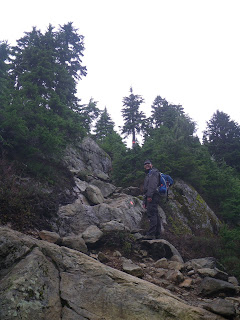While returning from the summit, we encountered a hiker heading toward the peak who appeared stressed, and asked us which way to the parking lot. We quickly got the directions sorted out, and invited the (no longer lost) hiker to join us for the hike out. Even without leaving the marked trail, it's easy to get lost around here, and if you miss a marker, it's easy to leave the trail and get really lost. The week before our hike, SAR had rescued a hiker who had taken a wrong turn, went off trail, and got stuck in a gully. The hiker was rescued safely, but the SAR folks have mentioned on other occasions that Mt. Seymour is one of their frequently visited locations.
The very beginning of the trail to the first peak (First Pump Peak) is clear and easy, but it isn't long before the trail becomes much less obvious and the terrain much steeper. Trail and not-trail started to require more skill to distinguish, and we realized why Mount Seymour is a popular place to get lost and require SAR help.
 |
| This is trail. Photo by Alex |
 |
| This is trail. Photo by Rhonda |
 |
| This is not trail. This is the top of a gully. Photo by Rhonda |
The most important safety tip I've learned about wayfinding in a formerly glaciated landscape such as BC is: in the absence of trail markers, don't follow streams downhill, even if at first it looks like easy going and you can see city through the break in the trees, as you can in the above photo. That way lies danger. If you don't have valley bottoms that connect in a useful way, ridge tops are the way to get around. (Although they're often not easy either!)
 |
| A hanging valley, with stream gully at the open end. Photo and clumsy annotations by Rhonda |
If you look at a topographic trail map for any of the glacier-carved mountains in the area, you'll see that the trails often follow ridge tops. Both the Mount Seymour trail and the Burke Mountain trail do this, which is why both hikes go over or very near multiple peaks. The ridge top marked in the photo above is a section of the Lynn Peaks route that runs from Lynn Peak to the Needles.
On the Mount Seymour trail, the second peak (Tim Jones Peak) and third peak (Mt. Seymour) are less than half a kilometre apart, but that short distance was as deceptive as the distance between Burke's second and third peaks. Fortunately we had allowed plenty of time and could have a picnic at the peak, near the geological survey marker that indicates the official top of Mt. Seymour, before our turnaround time.
 |
| Tuff is pretty tough. Photo by Rhonda |
 |
| Now imagine this trail with waist deep snow. Photo by Rhonda |
On another trip, about a month after first snow, we did not even attempt that trail, but went to Dog Mountain instead, an area with terrain suitable for snow-covered conditions and which had an established and marked snowshoeing route. This was a deliberately easy hike, because Alex was testing out his new snowshoes, including going very short distances off trail to test the limits of their abilities in a safe situation — such as going down a steep slope that was only a few steps high so there was limited risk of injury if their traction failed and he fell. We never went far from the trail, of course; we didn't want to lose our way.
 |
| That trail sign is usually at eye height. Photo by Rhonda |
Even if we had made a wrong turn that led to us being lost, we always leave a trip plan with a route and an expected return time with a responsible person, so if we don't get back when expected, at least SAR knows which mountain to search for us on and which trail to start with. Not doing that, well... while I was writing this post, a pair of hikers who hadn't left a trip plan went missing; the search started with police trying to contact the owner of a car found by Cypress Resort staff in the parking lot while closing up that night. Given that Cypress closes their lifts at 10PM and it takes time for all resort visitors to pack up and leave, this was most likely well over 6 hours after the hikers' intended return time. (Sunset was at 4:20PM that day, and it is dark under the trees quite a while before that.) Might they have been found if they had a responsible person to call for help at 4:30PM with a trail or peak name? Maybe, maybe not, but SAR wouldn't have had the multiple peaks of Cypress Provincial Park to spread their efforts over and would have been able to focus in more detail on the probable areas where the hikers might have been lost. The odds would have been better.
We have not ourselves needed SAR help and don't ever want to, and we don't want other people to need it either. One way we approach this is that we tell all the people we see heading away from the trailhead near the end of the day about sunset and how long it is before dark, and try to turn them around or at least set a safer goal given the time left. Sometimes they appreciate the information, sometimes they refuse to listen, but we still tell them.
For reasons that should be obvious at this point, we love AdventureSmart, and especially their slogan of "search and rescue prevention." We will happily put in the effort to prevent our local SAR teams from having work whenever we can.